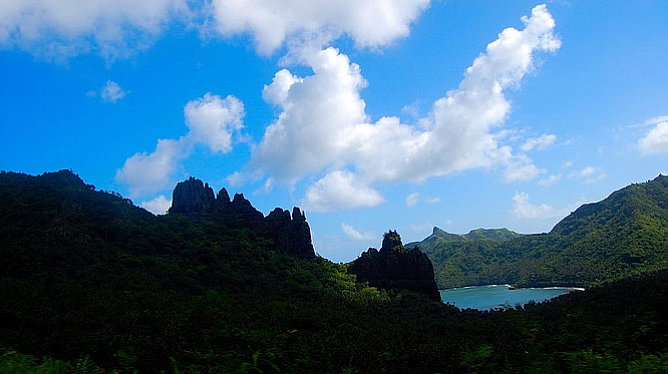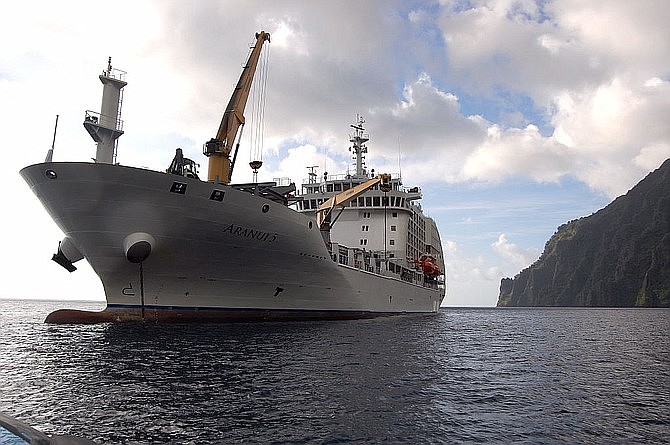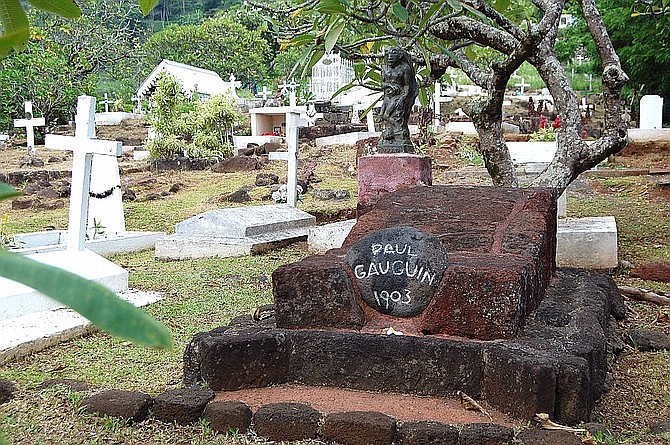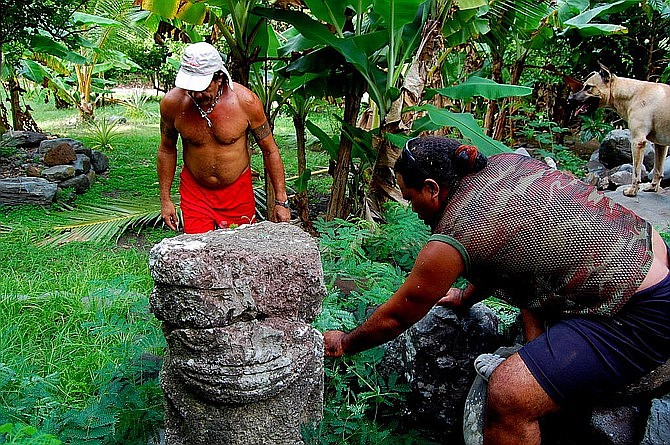 Facebook
Facebook
 X
X
 Instagram
Instagram
 TikTok
TikTok
 Youtube
Youtube

The South Pacific’s remote, pristine Marquesas Islands make Hawaii look like Harlem. I can honestly say these South Seas sojourns to French Polynesia’s untrammeled atolls and isles have been the greatest excursions of my life.

Recently, I returned to paradise, making my seventh voyage since 1991 to the Marquesas, located in between Tahiti and Honolulu, aboard the cargo-cruiser Aranui, the archipelago’s main transport and commerce link.
Launched last December, Aranui 5 combines features of a tramp steamer with the creature comforts of a passenger ship. The custom-built 413-foot long, 10-level vessel features fours bars, including two with panoramic vistas, a large restaurant, spa, fitness room and an outdoor freshwater pool adjacent to a deck where feasts and dance extravaganzas occur. Dominated by a king size bed, my snug 118-square foot stateroom offered a big porthole, daily maid service, phone and flat screen TV.
The Aranui — Tahitian for “the Big Highway” — is owned by the Wongs, a Tahiti-based Chinese family (with offices in San Mateo) that’s been in the maritime business since the 1920s. Crewed mostly by Pacific Islanders, observing brawny, bronzed, tattooed Polynesian sailors load and unload the ship’s cargo can be as entertaining as watching Cirque de Soleil.
First stop is Takapoto, a flat, coral atoll in the Tuamotus, with a lagoon ideal for snorkeling and beachside picnicking.
Nuku Hiva is a drop-dead-gorgeous emerald island with Taiohae Bay, shaped like a horseshoe, as Herman Melville wrote after he jumped ship there in 1842 to escape the tyrannical captain of his whaler. Melville’s “life among the cannibals” at Taipivai Valley formed the basis of his first novel, 1846’s Typee. 2016 was its 170th anniversary. Melville is depicted in the 2015 movie In the Heart of the Sea, about the real-life incident that inspired his masterpiece Moby Dick.
Aranui's Nuku Hiva stop included Polynesian feasts with fresh lobster, shrimp, roast suckling pig, breadfruit, poi (Marquesan style pudding), pineapples, etc., cooked in earthen ovens. These luaus are served in restaurants with live Tahitian music at Hatiheu village’s Chez Yvonne and Taipivai’s Chez Simon, adjacent to a tohua — ceremonial site — full of stone tiki images.

Exquisite Fatu Hiva, home of the “Bay of Virgins,” is where Norwegian archaeologist Thor Heyerdahl “returned to nature” in the 1930s, as recounted in the 2012 movie Kon-Tiki. At Hiva Oa, the fabled painter Paul Gauguin spent the last years of his life. He's buried there near singer Jacques Brel. A reproduction of Gauguin’s thatch-roofed House of Pleasures plus Brel’s twin-prop plane are inside museums in Atuona, Hiva Oa.
En route across 800 miles of open sea back to Tahiti, Aranui makes landfall at the Tuamotu atoll of Rangiroa (“the Everlasting Heaven”), with Polynesia’s largest lagoon — a superb place for scuba diving, filled with sharks, manta rays, turtles and brilliantly colored coral. I know, because that’s where I learned to dive! Leaping dolphins often lead the Aranui through the pass in the reef to and from the lagoon.
On the last full day of the two-week voyage, Aranui drops anchor at what James Michener called “the most beautiful island in the world” - twin-peaked Bora Bora. Passengers can enjoy circle isle tours, swimming, snorkeling and shark and stingray feeding. The following day the oceanic odyssey ends when Aranui returns to Tahiti.
This soft adventure’s first and final port-of-call in the Marquesas is at Ua Pou - Marquesan for “the Pillars” - where, as in the rest of this far-flung archipelago, there are no high rises or luxury resorts. During our initial Ua Pou landfall Aranui passengers enjoyed Chez Tata Rosalie’s luau and traditional Polynesian dances. However, on our return trip we had to decide how to spend three hours there while the passenger-freighter discharged cargo and loaded copra. Forgoing cold beers and handicraft-browsing at Hakahau village, shipmates Sylvain and Annick - a Parisian photographer and doctor - and I spontaneously chose to explore Ua Pou on our own.
We intrepid Aranui argonauts approached Romain, a 20-something tattooed islander, who agreed to drive us; soon Hakahau, paved roads and “civilization” were in his battered pickup’s rearview mirror. First stop presented commanding views of Hakahau’s basalt peaks, which Robert Louis Stevenson had described as “volcanic arrows looking like a church bell tower” in his 1891 In the South Seas.
Offroading into “deepest, darkest” Ua Pou revealed glimpses of barely populated valleys and untouched beaches, until we reached Hakamoui. There, resident Harris and his dogs Riki and Ganja joined our spur-of-the-moment expedition. The Marquesans led us into the jungle, onto an overgrown paepae — raised stone platform — moving thorny branches aside as we trod over uncertain rocks.

Across the hidden ancient temple, its back to us, was an unremarkable-looking meter-high slab, which Romain reverently showed us, divulging a tiki god with the wide eyes, flat nose, broad mouth, folded hands that a Marquesan Michelangelo carved centuries ago.
Romain noted other eroded, smaller tikis sculpted into the paepae. Harris picked fresh fruit for us.
Our archaeologists were untrained, but their ancestors had created these craggy gods and they knew where to find them. Instead of playing tourist, we ended our voyage to the Marquesas — where Polynesia’s largest stone statues beyond Rapa Nui stand — with an unforgettable adventure unveiling the face of god.
As Stevenson had written more than a century before, encountering an untouched South Pacific isle “touched a virginity of sense.”


The South Pacific’s remote, pristine Marquesas Islands make Hawaii look like Harlem. I can honestly say these South Seas sojourns to French Polynesia’s untrammeled atolls and isles have been the greatest excursions of my life.

Recently, I returned to paradise, making my seventh voyage since 1991 to the Marquesas, located in between Tahiti and Honolulu, aboard the cargo-cruiser Aranui, the archipelago’s main transport and commerce link.
Launched last December, Aranui 5 combines features of a tramp steamer with the creature comforts of a passenger ship. The custom-built 413-foot long, 10-level vessel features fours bars, including two with panoramic vistas, a large restaurant, spa, fitness room and an outdoor freshwater pool adjacent to a deck where feasts and dance extravaganzas occur. Dominated by a king size bed, my snug 118-square foot stateroom offered a big porthole, daily maid service, phone and flat screen TV.
The Aranui — Tahitian for “the Big Highway” — is owned by the Wongs, a Tahiti-based Chinese family (with offices in San Mateo) that’s been in the maritime business since the 1920s. Crewed mostly by Pacific Islanders, observing brawny, bronzed, tattooed Polynesian sailors load and unload the ship’s cargo can be as entertaining as watching Cirque de Soleil.
First stop is Takapoto, a flat, coral atoll in the Tuamotus, with a lagoon ideal for snorkeling and beachside picnicking.
Nuku Hiva is a drop-dead-gorgeous emerald island with Taiohae Bay, shaped like a horseshoe, as Herman Melville wrote after he jumped ship there in 1842 to escape the tyrannical captain of his whaler. Melville’s “life among the cannibals” at Taipivai Valley formed the basis of his first novel, 1846’s Typee. 2016 was its 170th anniversary. Melville is depicted in the 2015 movie In the Heart of the Sea, about the real-life incident that inspired his masterpiece Moby Dick.
Aranui's Nuku Hiva stop included Polynesian feasts with fresh lobster, shrimp, roast suckling pig, breadfruit, poi (Marquesan style pudding), pineapples, etc., cooked in earthen ovens. These luaus are served in restaurants with live Tahitian music at Hatiheu village’s Chez Yvonne and Taipivai’s Chez Simon, adjacent to a tohua — ceremonial site — full of stone tiki images.

Exquisite Fatu Hiva, home of the “Bay of Virgins,” is where Norwegian archaeologist Thor Heyerdahl “returned to nature” in the 1930s, as recounted in the 2012 movie Kon-Tiki. At Hiva Oa, the fabled painter Paul Gauguin spent the last years of his life. He's buried there near singer Jacques Brel. A reproduction of Gauguin’s thatch-roofed House of Pleasures plus Brel’s twin-prop plane are inside museums in Atuona, Hiva Oa.
En route across 800 miles of open sea back to Tahiti, Aranui makes landfall at the Tuamotu atoll of Rangiroa (“the Everlasting Heaven”), with Polynesia’s largest lagoon — a superb place for scuba diving, filled with sharks, manta rays, turtles and brilliantly colored coral. I know, because that’s where I learned to dive! Leaping dolphins often lead the Aranui through the pass in the reef to and from the lagoon.
On the last full day of the two-week voyage, Aranui drops anchor at what James Michener called “the most beautiful island in the world” - twin-peaked Bora Bora. Passengers can enjoy circle isle tours, swimming, snorkeling and shark and stingray feeding. The following day the oceanic odyssey ends when Aranui returns to Tahiti.
This soft adventure’s first and final port-of-call in the Marquesas is at Ua Pou - Marquesan for “the Pillars” - where, as in the rest of this far-flung archipelago, there are no high rises or luxury resorts. During our initial Ua Pou landfall Aranui passengers enjoyed Chez Tata Rosalie’s luau and traditional Polynesian dances. However, on our return trip we had to decide how to spend three hours there while the passenger-freighter discharged cargo and loaded copra. Forgoing cold beers and handicraft-browsing at Hakahau village, shipmates Sylvain and Annick - a Parisian photographer and doctor - and I spontaneously chose to explore Ua Pou on our own.
We intrepid Aranui argonauts approached Romain, a 20-something tattooed islander, who agreed to drive us; soon Hakahau, paved roads and “civilization” were in his battered pickup’s rearview mirror. First stop presented commanding views of Hakahau’s basalt peaks, which Robert Louis Stevenson had described as “volcanic arrows looking like a church bell tower” in his 1891 In the South Seas.
Offroading into “deepest, darkest” Ua Pou revealed glimpses of barely populated valleys and untouched beaches, until we reached Hakamoui. There, resident Harris and his dogs Riki and Ganja joined our spur-of-the-moment expedition. The Marquesans led us into the jungle, onto an overgrown paepae — raised stone platform — moving thorny branches aside as we trod over uncertain rocks.

Across the hidden ancient temple, its back to us, was an unremarkable-looking meter-high slab, which Romain reverently showed us, divulging a tiki god with the wide eyes, flat nose, broad mouth, folded hands that a Marquesan Michelangelo carved centuries ago.
Romain noted other eroded, smaller tikis sculpted into the paepae. Harris picked fresh fruit for us.
Our archaeologists were untrained, but their ancestors had created these craggy gods and they knew where to find them. Instead of playing tourist, we ended our voyage to the Marquesas — where Polynesia’s largest stone statues beyond Rapa Nui stand — with an unforgettable adventure unveiling the face of god.
As Stevenson had written more than a century before, encountering an untouched South Pacific isle “touched a virginity of sense.”
Comments